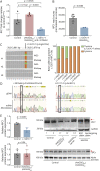Truncating Variants in RFC1 in Cerebellar Ataxia, Neuropathy, and Vestibular Areflexia Syndrome
- PMID: 36289003
- PMCID: PMC9931080
- DOI: 10.1212/WNL.0000000000201486
Truncating Variants in RFC1 in Cerebellar Ataxia, Neuropathy, and Vestibular Areflexia Syndrome
Abstract
Background and objective: Cerebellar ataxia, neuropathy, and vestibular areflexia syndrome (CANVAS) is an autosomal recessive neurodegenerative disease characterized by adult-onset and slowly progressive sensory neuropathy, cerebellar dysfunction, and vestibular impairment. In most cases, the disease is caused by biallelic (AAGGG)n repeat expansions in the second intron of the replication factor complex subunit 1 (RFC1). However, a small number of cases with typical CANVAS do not carry the common biallelic repeat expansion. The objective of this study was to expand the genotypic spectrum of CANVAS by identifying sequence variants in RFC1-coding region associated with this condition.
Methods: Fifteen individuals diagnosed with CANVAS and carrying only 1 heterozygous (AAGGG)n expansion in RFC1 underwent whole-genome sequencing or whole-exome sequencing to test for the presence of a second variant in RFC1 or other unrelated gene. To assess the effect of truncating variants on RFC1 expression, we tested the level of RFC1 transcript and protein on patients' derived cell lines.
Results: We identified 7 patients from 5 unrelated families with clinically defined CANVAS carrying a heterozygous (AAGGG)n expansion together with a second truncating variant in trans in RFC1, which included the following: c.1267C>T (p.Arg423Ter), c.1739_1740del (p.Lys580SerfsTer9), c.2191del (p.Gly731GlufsTer6), and c.2876del (p.Pro959GlnfsTer24). Patient fibroblasts containing the c.1267C>T (p.Arg423Ter) or c.2876del (p.Pro959GlnfsTer24) variants demonstrated nonsense-mediated mRNA decay and reduced RFC1 transcript and protein.
Discussion: Our report expands the genotype spectrum of RFC1 disease. Full RFC1 sequencing is recommended in cases affected by typical CANVAS and carrying monoallelic (AAGGG)n expansions. In addition, it sheds further light on the pathogenesis of RFC1 CANVAS because it supports the existence of a loss-of-function mechanism underlying this complex neurodegenerative condition.
Copyright © 2022 The Author(s). Published by Wolters Kluwer Health, Inc. on behalf of the American Academy of Neurology.
Figures


References
-
- Cortese A, Curro’ R, Vegezzi E, Yau WY, Houlden H, Reilly MM. Cerebellar ataxia, neuropathy and vestibular areflexia syndrome (CANVAS): genetic and clinical aspects. Pract Neurol. 2022;22(1):14-18. - PubMed
-
- Cortese A, Reilly MM, Houlden H. RFC1 CANVAS/spectrum disorder. In: Adam MP, Ardinger HH, Pagon RA, et al., editors. GeneReviews®. University of Washington, Seattle; 1993. ncbi.nlm.nih.gov/books/NBK564656/. Accessed January 5, 2021. - PubMed
Publication types
MeSH terms
Grants and funding
LinkOut - more resources
Full Text Sources
Medical
